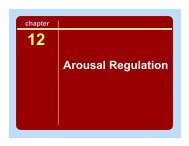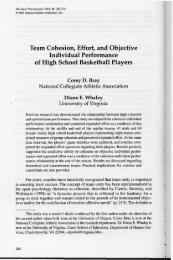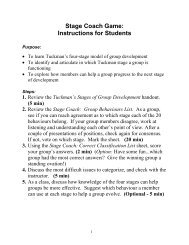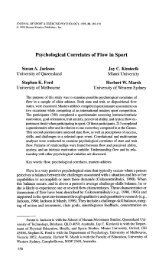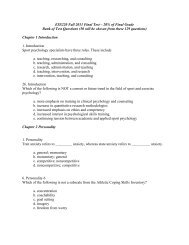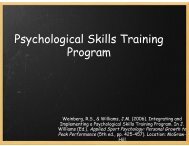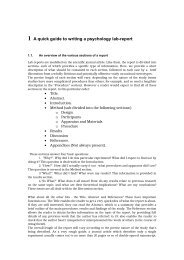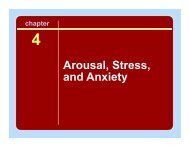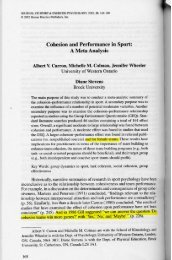Sport and Exercise Psychology Review - Sport Psychology Goes to ...
Sport and Exercise Psychology Review - Sport Psychology Goes to ...
Sport and Exercise Psychology Review - Sport Psychology Goes to ...
You also want an ePaper? Increase the reach of your titles
YUMPU automatically turns print PDFs into web optimized ePapers that Google loves.
Mark A. Uphill & Marc V. Jones<br />
post-intervention (anxiety, disappointment).<br />
Support for this contention was given further<br />
credence by the number of overlapping<br />
data points <strong>and</strong> the absence of an immediate<br />
post-intervention effect. Two exceptions<br />
<strong>to</strong> this trend were evident however,<br />
with regret (ES = 2.46) <strong>and</strong> embarrassment<br />
(ES = 0.60) demonstrating practically significant<br />
reductions post-intervention. No statistically<br />
significant changes in emotional state<br />
pre- <strong>to</strong> post-intervention were demonstrated<br />
(p > .003).<br />
The consultant evaluation form indicated<br />
that the participant was extremely satisfied<br />
with the intervention he received: the<br />
impact of the intervention was rated positively<br />
(rated 5 on a scale of 1 <strong>to</strong> 5) <strong>and</strong> the<br />
manner in which the intervention was delivered<br />
was also regarded positively (rated no<br />
less than 8 on a scale of 0 <strong>to</strong> 10). In an e-mail<br />
twenty four months after the intervention,<br />
the participant reported the following:<br />
‘All is going well for me – my golf game<br />
remains in good shape <strong>and</strong> thinking/focus/<br />
decision making is getting clearer all the time<br />
(particularly in competitive/pressure situations)<br />
thanks <strong>to</strong> the “see it, feel it, do it”<br />
stuff that we worked on all that time ago…’<br />
This e-mail indicated that the participant<br />
was able <strong>to</strong> incorporate all aspects of the<br />
extended pre-shot routine (verbal cues,<br />
kinaesthetic imagery) in<strong>to</strong> his competitive<br />
performance.<br />
Discussion<br />
This study examined the use of a cognitivebehavioural<br />
intervention <strong>to</strong> (a) enhance<br />
the participant’s concentration immediately<br />
preceding a shot, <strong>and</strong> (b) facilitate<br />
the participant’s capacity <strong>to</strong> cope adaptively<br />
when a careless shot was committed.<br />
In support of previous research (Boutcher<br />
& Zinsser, 1990; Lobmeyer & Wasserman,<br />
1986), this study demonstrated a perceived<br />
improvement in the participant’s pre-shot<br />
concentration, which was accompanied by<br />
a practically significant reduction in the<br />
frequency of careless shots post-intervention.<br />
Although the former observation was<br />
less clear-cut (several overlapping data<br />
points), because the participant’s pre-shot<br />
concentration was only assessed on those<br />
shots he perceived <strong>to</strong> be careless (of which<br />
there were fewer post – intervention), the<br />
magnitude of any change in concentration<br />
pre- <strong>to</strong> post-intervention is likely <strong>to</strong> be<br />
reduced.<br />
Results also suggest that the intervention<br />
was partially effective in assisting the participant<br />
cope adaptively with the occurrence of<br />
careless shots. Specifically, concentration<br />
<strong>and</strong> motivation after an error were both significantly<br />
<strong>and</strong> practically enhanced postintervention.<br />
Redirecting attention <strong>to</strong> taskrelevant<br />
cues can be considered an emotionfocussed<br />
coping strategy, while enhanced<br />
motivation may reflect problem-focussed<br />
talk (Holt & Hogg, 2002) rather than<br />
attempts <strong>to</strong> deal directly with the error (e.g.<br />
modifying technique). With the exception of<br />
regret, there was little pre- <strong>to</strong> post-intervention<br />
change in the intensity of the participant’s<br />
emotional state. Although a more<br />
sensitive analysis, incorporating an assessment<br />
of emotion intensity <strong>and</strong> duration may<br />
have been beneficial in retrospect (cf. Beck<br />
& Fern<strong>and</strong>ez, 1998), <strong>to</strong> account for the<br />
reduction in the intensity of some emotions<br />
but not others, one is drawn <strong>to</strong> characteristics<br />
that may distinguish between these<br />
emotions. One explanation may concern<br />
characteristics of the appraisal process, particularly<br />
the concept of intuitive <strong>and</strong> reflective<br />
appraisals (Valler<strong>and</strong>, 1987). Regret is<br />
experienced when people look back on bad<br />
decisions (Zeelenberg et al., 2002), <strong>and</strong> may<br />
therefore be characterised by a reflective<br />
appraisal process. Recognising that appraisal<br />
of stimuli may occur at different speeds <strong>and</strong><br />
levels (conscious through <strong>to</strong> unconscious), it<br />
may be speculated that appraisals associated<br />
with emotions such as anger <strong>and</strong> disappointment<br />
may be characterised by rapid <strong>and</strong><br />
unconscious ‘intuitive’ appraisals when compared<br />
<strong>to</strong> regret. Cognitive interventions may<br />
be more effective at changing athletes’ conscious,<br />
rather than unconscious appraisal<br />
processes (see Jones, 2003).<br />
20 <strong>Sport</strong> & <strong>Exercise</strong> <strong>Psychology</strong> <strong>Review</strong> Vol 1 No 2



